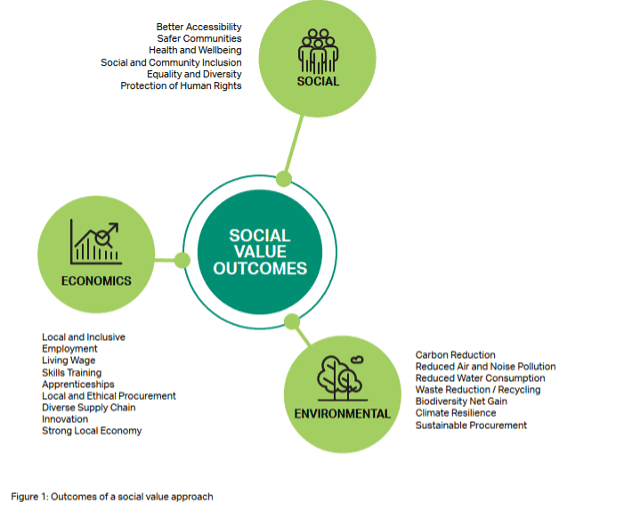
The data-elevated, social governance-focused city

Infrastructure investment is increasingly used as a driver of social change and development. But how can digital help cities to plan and design social infrastructure, optimizing sustainable outcomes and promoting better governance?
With growing urbanization, the world needs more infrastructure. Estimates put the annual spending on infrastructure for the Asia region at up to US$1.7 trillion by 2030. This infrastructure is crucial for accelerating social change and development — housing, schools and hospitals that yield public benefits, or bridges and highways that provide socio-economic advantages to help cities grow.
But how do we ensure that the benefits derived from this infrastructure investment are allocated fairly and inclusively to address the needs of disparate communities?
The answer lies in embedding social value in all infrastructure projects and — importantly — adopting a social value-centric approach, centered on a strong governance framework with measurable outcomes.
Applying social governance at project level
According to the European Union, social governance is defined as the process of governing societies in a situation where no single actor can claim absolute dominance.
As a theoretical concept, it refers to all processes of social organization and social coordination. Social governance is therefore key to ensuring equitable distribution of social benefits and guaranteeing that the process of decision-making and cost allocation is transparent and accountable.
Yet too often we encounter infrastructure projects that fail to meet their objectives of delivering social value, due to overruns of budget and project timelines, and misalignment with the governance demands placed on the delivery parties by the funding authorities.
What this shows is that governance — especially social governance — needs to be enforced at the project level early on rather than later to avoid costly mistakes and the delivery of unintended social outcomes.
Digital can play a role in making this happen. Acquiring the right baseline data at the planning stage and creating “what-if” models allow planners to predict outcomes, measure socio-economic cost- benefits and show how the intervention of infrastructure can yield net positive returns.
Still, the question arises: how do we apply governance — social or otherwise — at the project level to ensure that the delivery parties follow the planning instructions diligently? There are various means.
- Establish a social value statement upfront, declaring the intent of the project. In setting up an infrastructure project, it is important to incorporate the right project methodology, part of which is a social value statement underpinning the social outcomes to be delivered. Social value statements focus on socio-economic benefits, including jobs created, livelihoods affected, impacts on traditional practices, and community health and safety issues. Fundamentally, such a statement will put social values at the heart of a project. In 2019, for example, the U.K. government consulted on its proposed approach to help public sector organizations maximize social value effectively through their procurement as required by the Public Services (Social Value) Act 2012. The result is that it is now commonplace within tenders and bids to have a social value statement next to the bidding fee.

-
Set up a governance structure showing the accountability of different parties. It is often poor governance, rather than scarce financing, that is the main impediment to efficient, effective, and sustainable infrastructure services. In response, the World Bank has created the Infrastructure Governance Framework, which identifies three key areas for attention. First, on selecting, designing, procuring, and implementing new infrastructure assets, the project must demonstrate that it offers value for money, that it is affordable for the public purse and users, and that it is sustainable. Second, social, environmental and climate change considerations must be fully integrated into every phase of the project’s life. Finally, ongoing infrastructure services must be provided to citizens without disruption during the project, and relevant and independent regulatory frameworks for sectors such as power, water and transport should be maintained. Governments involved in provision of these services should also have clear roles and responsibilities, manage their risks, and ensure that there is a level playing field with respect to themselves and other market players.
-
Engage with stakeholders to understand their needs. Stakeholder management contributes to governance by helping to handle the multiple and often conflicting concerns held by the complex networks of groups that surround any infrastructure project. Stakeholder engagement is a fundamental building block for transparency, accountability and the rulemaking process and, as such, the specifics of the engagement procedures require transparency, accountability and uniformity. According to OECD guidelines, a clear and comprehensive approach should be identified to state when, how and to what extent consultations with relevant stakeholders will take place. At the same time, identifying the appropriate stakeholders for a particular subject matter, defining relevant tools for participation, and deciding on the timing for consultations is essential in ensuring the effectiveness of the engagement, while clear, effective and detailed communications is essential in allowing for an effective two-way process.
-
Break down silos within the project team. Typically, a silo mentality can be a serious threat to a project. It closes team members off from each other and stifles the flow of information. The ability to make good business decisions, develop resolutions to problems, and even properly identify issues are all diminished if cooperation among cross-functional groups is hampered by organizational project silos. The implementation of the right project governance and methodology is critical to overcoming the problems project silos often bring. Strategies that leverage a team-based approach to planning are more effective, not only ensuring the availability of more accurate and comprehensive data when developing the project plan, but also the essential buy-in from team members.
-
Focus on measurable social outcomes as part of the project delivery process. Sound and robust data on who receives the benefits of infrastructure is imperative. There are numerous tools to measure social impact, most of which serve to monetize the impact into an easily understandable economic value. For example, AECOM developed an equity-based project prioritization tool for the City of Baltimore Department of Public Works (DPW) for their Capital Investment Planning for infrastructure. The main objectives were to improve visibility and impact of equity in DPW through the decision-making process and incorporate social, environmental, economic and operational criteria together with co-benefits for disadvantaged communities through a data-driven methodology that captured spatial and demographic context for projects and impacts.
Case Study: Creating a social value legacy at the LA2028 Olympics and Paralympics
Any major event attracts international attention and involves extensive planning, construction, and transformation of a city or region, with a legacy that encompasses planned and unplanned physical and non-physical changes, such as stadiums, transport routes, national construction strategies, and increased visibility for cities or neighborhoods. In 2017, the Los Angeles City Council was formally awarded the 2028 Olympic and Paralympic Games following a unanimous vote by the International Olympic Committee (IOC). While no permanent sports infrastructure is planned to be built, temporary event spaces and supporting infrastructure are required, such as transportation
and housing. The main aspiration, though, is to develop a strong social value legacy for the city,
especially in the following key pillars:
-
Community inclusion: The emphasis on community inclusion reflects a commitment to ensuring that all members of the community have equal opportunities and are actively involved in decision-making processes. By engaging with residents and considering their values and interests, the aim is to create a sense of belonging and co-creation, whilst promoting social cohesion. The LA2028 Games also provides a platform to raise awareness and catalyze positive change, promoting diversity and challenging societal norms and biases.
-
Knowledge building and workforce development: Recognizing the significance of knowledge building and workforce development, LA2028 aims to provide training and educational opportunities to equip individuals with new skills. The goal is to create a skilled workforce that is proactive in finding effective ways to address challenges and can contribute to the region's growth and prosperity.
-
Social equity: Ensuring fairness and equal access to resources and opportunities for all
community members is a key consideration. This includes addressing safety concerns,
minimizing environmental impact, and providing multimodal transportation options that benefit all residents. The emphasis is on making equitable investments that yield dividends and contribute
to the overall well-being of the community. This includes reparations for communities affected by infrastructure projects and promoting women, small businesses, and long-lasting job creation. -
Collaboration and community engagement: Collaboration between different agencies, stakeholders and the community is seen as crucial for achieving transformative goals. Community engagement ensures that any initiatives are responsive to the community's concerns, aspirations and values. It allows the consideration of broader social and human aspects, such as economic empowerment and community well-being. This collaborative approach fosters a sense of ownership and shared responsibility for the outcomes.
-
Sustainability and environmental responsibility: LA2028 prioritizes sustainability and environmental responsibility. Efforts are being made to mitigate the environmental impact of ransportation and port operations, with initiatives like the Clean Air Action Plan and a goal of achieving zero emissions. By minimizing negative impacts on the community and promoting a sustainable future, these initiatives aim to create a healthier and more resilient environment.
Case Study: Equity-based decision- making on Maryland Light Rail Project
The Purple Line is a light rail line being built in the U.S. state of Maryland. The line traverses east to west across two counties, several Maryland suburbs and 16.2 miles (26.1 kilometers) of densely populated, socially and economically diverse urban communities. AECOM worked with Maryland Transit Administration (MTA) staff to identify and carry out equity-based priorities on the project, partnering with community focus groups and neighborhood work groups to evaluate local impacts of the project, and to help MTA make equity-based decisions prior to the preliminary design phase. These include:
− Route selection – After studying multiple routes, considering engineering feasibility, operations, and populations served, such as areas with high percentages of zero-car households, MTA chose the preferred route because it was feasible, achieved operational goals, and served a diverse population.
− Housing affordability – MTA made a commitment to work with county land use planners to apply affordable housing regulations, thereby keeping neighborhoods surrounding the 21 Purple Line
stations affordable to people currently living in the corridor.
− Impacts to minority businesses during project construction – Factors such as temporary loss of or changes in access to businesses or business displacements were addressed through a Business Construction Impact Mitigation Plan. Members of the outreach team visited every business along the alignment. This communication and coordination formed the basis for impact mitigation efforts during construction.
− Local jobs – MTA created the Purple Line Workforce Development program to train and employ people from the local community in Purple Line operations and maintenance jobs. It is estimated that 4,800 new construction jobs, 1,500 professional, scientific and technical jobs, and 425 new permanent jobs in operations and maintenance were created directly from the Purple Line.
− Property impacts – Neighborhood-specific outreach programs were established to understand
residents’ needs and concerns related to displacement of homes, incorporating input from
the affected residents and homeowners and working with civic associations and local elected officials on proposed modifications.
− Location and configuration of project elements in low-income and minority communities –
MTA formed a neighborhood working group close to a proposed maintenance facility, which was desired by the neighborhood. The group helped to identify property that MTA could redevelop, as well as relocation sites for impacted businesses and community facilities.